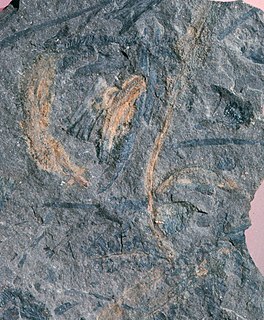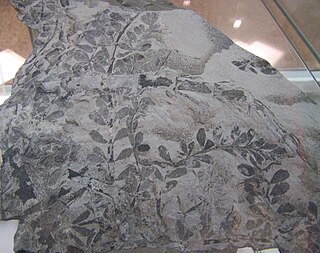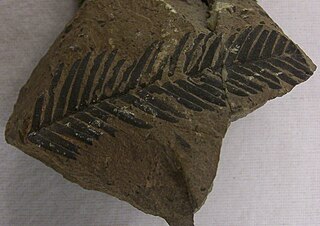 W
WAraucarioxylon arizonicum is an extinct species of conifer that is the state fossil of Arizona. The species is known from massive tree trunks that weather out of the Chinle Formation in desert badlands of northern Arizona and adjacent New Mexico and Chemnitz petrified forest in Chemnitz, Germany, most notably in the 378.51 square kilometres Petrified Forest National Park. There, these trunks are locally so abundant that they have been used as building materials.
 W
WThe Caytoniales are an extinct order of seed plants known from fossils collected throughout the Mesozoic Era, specifically in the late Triassic to Maastrichtian period, around 250 to 70 million years ago. They are regarded as seed ferns because they are seed-bearing plants with fern-like leaves. Although at one time considered angiosperms because of their berry-like cupules, that hypothesis was later disproven. Nevertheless, some authorities consider them likely ancestors of angiosperms, whereas others consider angiosperms more likely derived from Glossopteridales. The origin of angiosperms remains an intriguing puzzle.
 W
WCladophlebis is an extinct form genus of fern, used to refer to Paleozoic and Mesozoic fern leaves that have "fern fronds with pinnules that are attached to the rachis, and have a median vein that runs to the apex of the pinnule, and veins from that are curved and dichotomise". By convention this genus is not used to refer to fossil ferns from the Cenozoic. Ferns with this morphology belong to several families, including Osmundaceae, Dicksoniaceae and Schizaeaceae. Ferns with this morphology are common during the Paleozoic and Mesozoic in both the northern and southern hemispheres.
 W
WCorystospermaceae is a natural family of seed ferns (Pteridospermatophyta) also called Umkomasiaceae, and first based on fossils collected by Hamshaw Thomas from the Burnera Waterfall locality near the Umkomaas River of South Africa The leaves of Dicroidium were recognized by Alex Du Toit to unite all the countries of the Gondwana supercontinent during the Triassic: Africa, South America, India, and Australia. Subsequently, Dicroidium was found in the Triassic of Antarctica and New Zealand, and also the Permian Umm Irna Formation of Jordan. According to the form generic system of paleobotany, leaves are given separate generic names to ovulate and pollen organs, but the discovery of these reproductive organs in Africa by Thomas, and subsequently throughout Gondwana, strengthened Du Toit's concept of a continuous southern supercontinent. Corystospermaceae were also components of Jurassic and Cretaceous floras, declining in the Cretaceous presumably due to the rise of flowering plants, the last representative of the group, Komlopteris cenozoicus, is known from the Eocene of Tasmania.
 W
WCylostrobus is genus of Lycopsida most like Pleuromeia, but with very compact and round cones. It is known from the Early Triassic of Australia, coincident with a marked greenhouse spike at the end of the Early Triassic. The genus Cylostrobus was erected for the compact cone only, in the paleobotanical system of form genera, but these small plants are well enough understood that the name Cylostrobus sydneyensis is used for the whole plant, rather than the old name Pleuromeia longicaulis. Other species of Pleuromeia have attached cones that are less compact and produce different spores.
 W
WDicroidium is an extinct genus of fork-leaved seed ferns that were widely distributed over Gondwana during the Triassic. Their fossils are known from South Africa, the Arabian Peninsula, Australia, New Zealand, South America, Madagascar, the Indian subcontinent and Antarctica. They were first discovered in Triassic sediments of Tasmania by Morris in 1845. Fossils from the Umm Irna Formation in Jordan and in Pakistan indicate that these plants already existed in Late Permian. Late surviving members of the genus are known from the Early Jurassic (Sinemurian) of East Antarctica.
 W
WDicroidium odontopteroides was a common and widespread species of Dicroidium known from South Africa, Australia, New Zealand, South America and Antarctica. The species was first discovered in Triassic sediments of Tasmania and described by the palaeontologist John Morris in 1845.
 W
WDicroidium zuberi is a large bipinnate species of the seed fern Dicroidium with a forked rachis. The leaves are affiliated with Umkomasia feistmantellii megasporophylls and Petruchus barrealensis microsporophylls.
 W
WDiplopora is a genus of marine dasycladacean algae in the family Diploporaceae.
 W
WGinkgoites is a genus that refers to extinct plants belonging to Ginkgoaceae. Fossils of these plants have been found around the globe during the Triassic, Jurassic and Cretaceous. The name was created as a form genus in 1919 by Albert Seward who stated: "I ... propose to employ the name Ginkgoites for leaves that it is believed belong either to plants generically identical with Ginkgo or to very closely allied types".
 W
WGyroporella is an extinct genus of green algae in the family Triploporellaceae.
 W
WLepidopteris is a form genus for leaves of Late Permian to Late Triassic Period Pteridospermatophyta, or seed ferns, which lived from around 260 to 200 million years ago in what is now Australia, Antarctica, India, South America, South Africa, Russia and China. Nine species are currently recognized. Lepidopteris was a common and widespread seed fern, which survived the Permian-Triassic extinction event but succumbed to the Triassic-Jurassic extinction event. Lepidopteris callipteroides is especially common between the first two episodes of Permian-Triassic extinction event, and L. ottonis forms a comparable acme zone immediate before the Triassic-Jurassic extinction event.
 W
WLepidopteris callipteroides is a form species for leaves of Late Permian Pteridospermatophyta, or seed ferns, which lived from around 252 million years ago in what is now Australia, and Madagascar. Lepidopteris callipteroides was an immediate survivor of the largest Permian-Triassic extinction event, migrating southward with the post-apocalyptic greenhouse spike.
 W
WPeltaspermaceae is a natural family of seed ferns (Pteridospermatophyta) widespread in both northern and southern hemispheres coal measures of Permian and Triassic age.
 W
WPleuromeia is an extinct genus of spore plants, assigned to the order Pleuromeiales in some approaches. Pleuromeia dominated vegetation during the Early Triassic all over Eurasia and elsewhere. Its sedimentary context in monospecific assemblages on immature paleosols, is evidence that it was an opportunistic pioneer plant that grew on mineral soils with little competition. It spread to high latitudes with greenhouse climatic conditions following the Permian-Triassic extinction event. Conifers reoccurred in the Early Anisian, followed by the cycads and pteridosperms during the Late Anisian.
 W
WPleuromeia dubia is a tall species for the genus, with distinctive elongate leaf scars, and known from the Early Triassic of Australia and South Africa. Like other species of Pleuromeia it was a survivor of the marked greenhouse spike at the end of the Early Triassic.
 W
WThe term Pteridospermatophyta refers to several distinct polyphyletic groups of extinct seed-bearing plants (spermatophytes). The earliest fossil evidence for plants of this type is the genus Elkinsia of the late Devonian age. They flourished particularly during the Carboniferous and Permian periods. Pteridosperms declined during the Mesozoic Era and had mostly disappeared by the end of the Cretaceous Period, though some pteridosperm-like plants seem to have survived into Eocene times, based on fossil finds in Tasmania.
 W
WPteruchus is a form genus for pollen organs of the seed fern (Pteridospermatophyta family Umkomasiaceae. It was first described by Hamshaw Thomas from the Umkomaas locality of South Africa.
 W
WPteruchus africanus is a pollen organ of a seed fern (Pteridospermatophyta). It was first described by Hamshaw Thomas from the Umkomaas locality of South Africa.
 W
WPteruchus barrealensis is an unusually large species of Pteruchus with very elongate polleniferous heads from Early Triassic of Australia and Argentina.
 W
WSagenopteris is a genus of extinct seed ferns from the Triassic to late Early Cretaceous.
 W
WThe term Pteridospermatophyta refers to several distinct polyphyletic groups of extinct seed-bearing plants (spermatophytes). The earliest fossil evidence for plants of this type is the genus Elkinsia of the late Devonian age. They flourished particularly during the Carboniferous and Permian periods. Pteridosperms declined during the Mesozoic Era and had mostly disappeared by the end of the Cretaceous Period, though some pteridosperm-like plants seem to have survived into Eocene times, based on fossil finds in Tasmania.
 W
WSphenophyllales is an extinct order of articulate land plants and a sister group to the present-day Equisetales (horsetails). They are fossils dating from the Devonian to the Triassic. They were common during the Late Pennsylvanian to Early Permian, with most of the fossils coming from the Carboniferous period.
 W
WSphenophyllales is an extinct order of articulate land plants and a sister group to the present-day Equisetales (horsetails). They are fossils dating from the Devonian to the Triassic. They were common during the Late Pennsylvanian to Early Permian, with most of the fossils coming from the Carboniferous period.
 W
WSphenopteris is a genus of seed ferns containing the foliage of various extinct plants, ranging from the Devonian to Late Cretaceous.
 W
WTomiostrobus is an extinct quillwort genus from the Early Triassic of Australia and Russia, which was especially widespread in the aftermath of Permian Triassic mass extinctions.
 W
WUmkomasia is a genus of seed ferns (Pteridospermatophyta), and first based on fossils collected by Hamshaw Thomas from the Burnera Waterfall locality near the Umkomaas River of South Africa. He recognized on the basis of cuticular similarities that the same plant produced pollen organs Pteruchus and the leaves Dicroidium.
 W
WUmkomasia feistmantelii is an unusually large species of Umkomasia from the Early Triassic of New South Wales, Australia.
 W
WUmkomasia macleanii is an ovulate structure of a seed fern (Pteridospermatophyta and the nominate genus of Family Umkomasiaceae. It was first described by Hamshaw Thomas from the Umkomaas locality of South Africa.
 W
WCorystospermaceae is a natural family of seed ferns (Pteridospermatophyta) also called Umkomasiaceae, and first based on fossils collected by Hamshaw Thomas from the Burnera Waterfall locality near the Umkomaas River of South Africa The leaves of Dicroidium were recognized by Alex Du Toit to unite all the countries of the Gondwana supercontinent during the Triassic: Africa, South America, India, and Australia. Subsequently, Dicroidium was found in the Triassic of Antarctica and New Zealand, and also the Permian Umm Irna Formation of Jordan. According to the form generic system of paleobotany, leaves are given separate generic names to ovulate and pollen organs, but the discovery of these reproductive organs in Africa by Thomas, and subsequently throughout Gondwana, strengthened Du Toit's concept of a continuous southern supercontinent. Corystospermaceae were also components of Jurassic and Cretaceous floras, declining in the Cretaceous presumably due to the rise of flowering plants, the last representative of the group, Komlopteris cenozoicus, is known from the Eocene of Tasmania.
 W
WWilliamsoniaceae is a family within the Bennettitales, an extinct group of seed plants within the Cycadophyta subdivision. Members of this family are believed to have been around two meters tall and with widely serrate leaves along a central stem. Reproductive organs of the Williamsoniaceae have varied widely in the fossil record but almost all have been found to be borne on stalks emerging from a ring of leaves.
 W
WZamites is a genus of fossil tree known from the Mesozoic of North America, Europe and India through the Eocene of North America. It is a form taxon for leaves that resemble the extant cycad Zamia. The fronds are linear or lanceolate in shape, and pinnately compound, with pinnae with parallel veins and smooth margins, and symmetrical and constricted at the base where they are attached obliquely to the upper surface of the rachis. It has been interpreted as a cycad in the family Cycadaceae or a Bennettitalean plant.